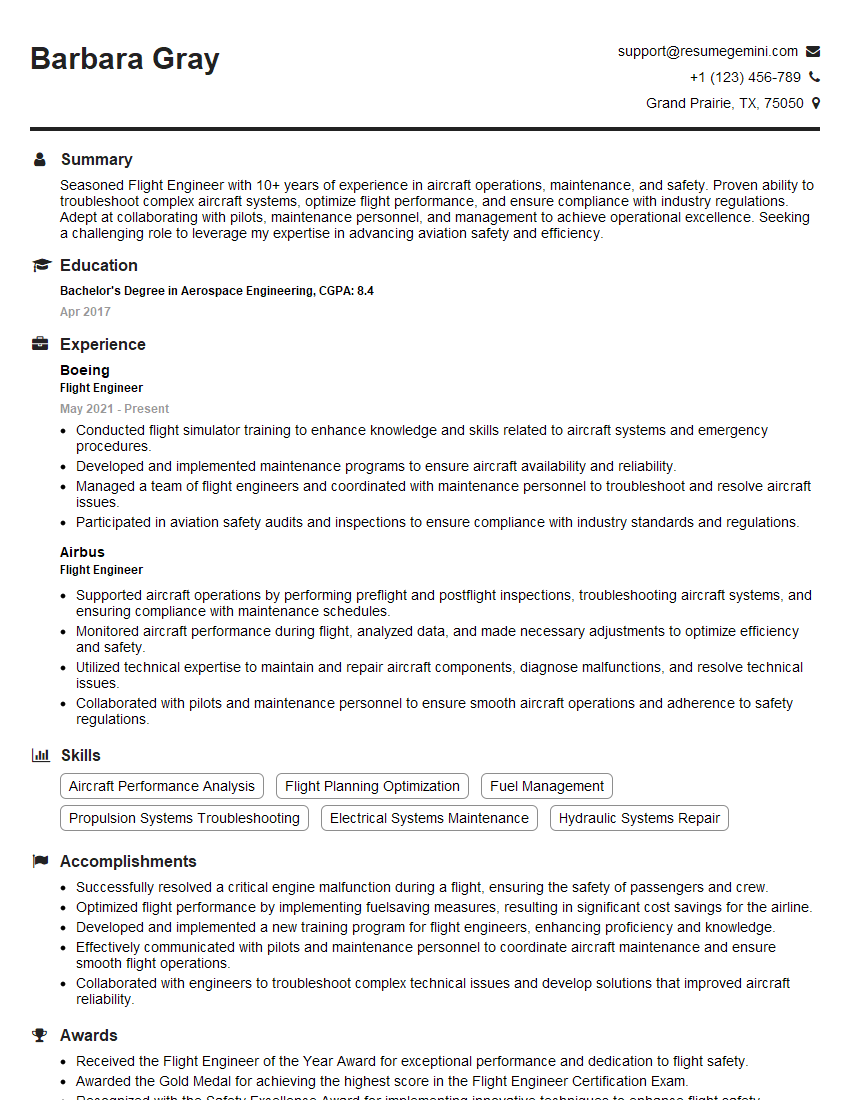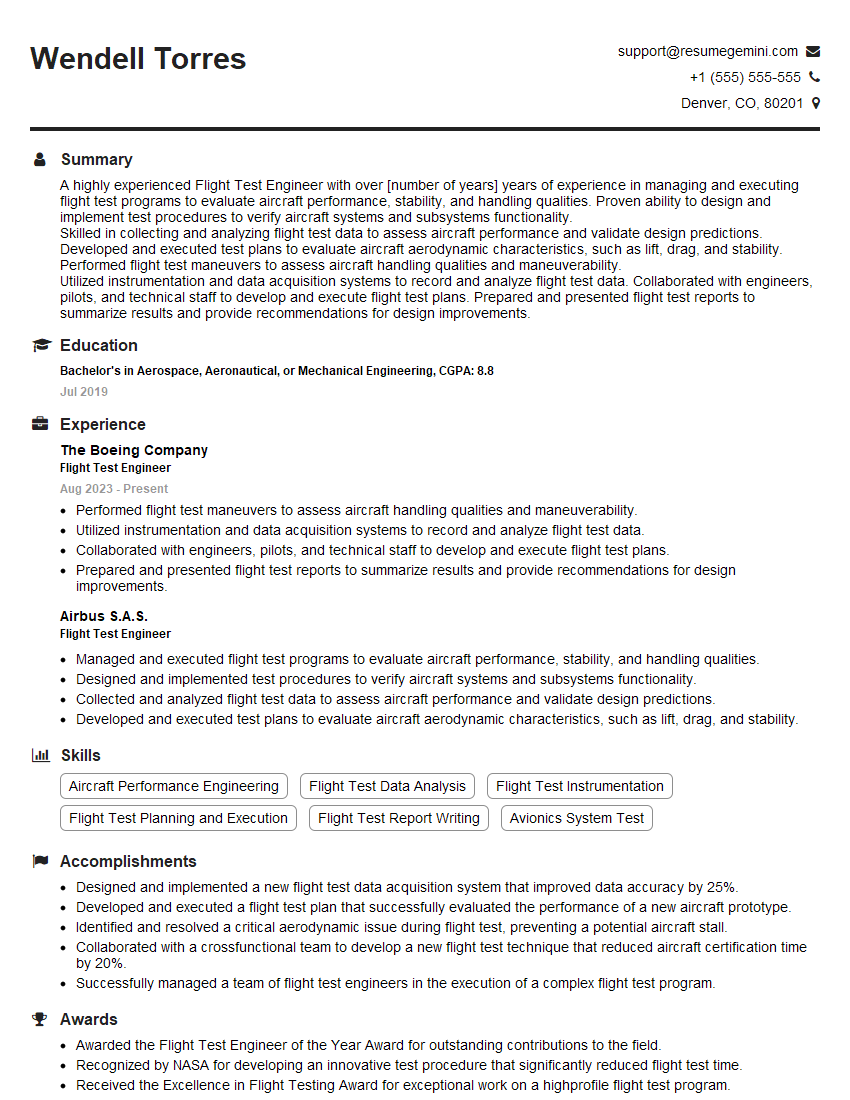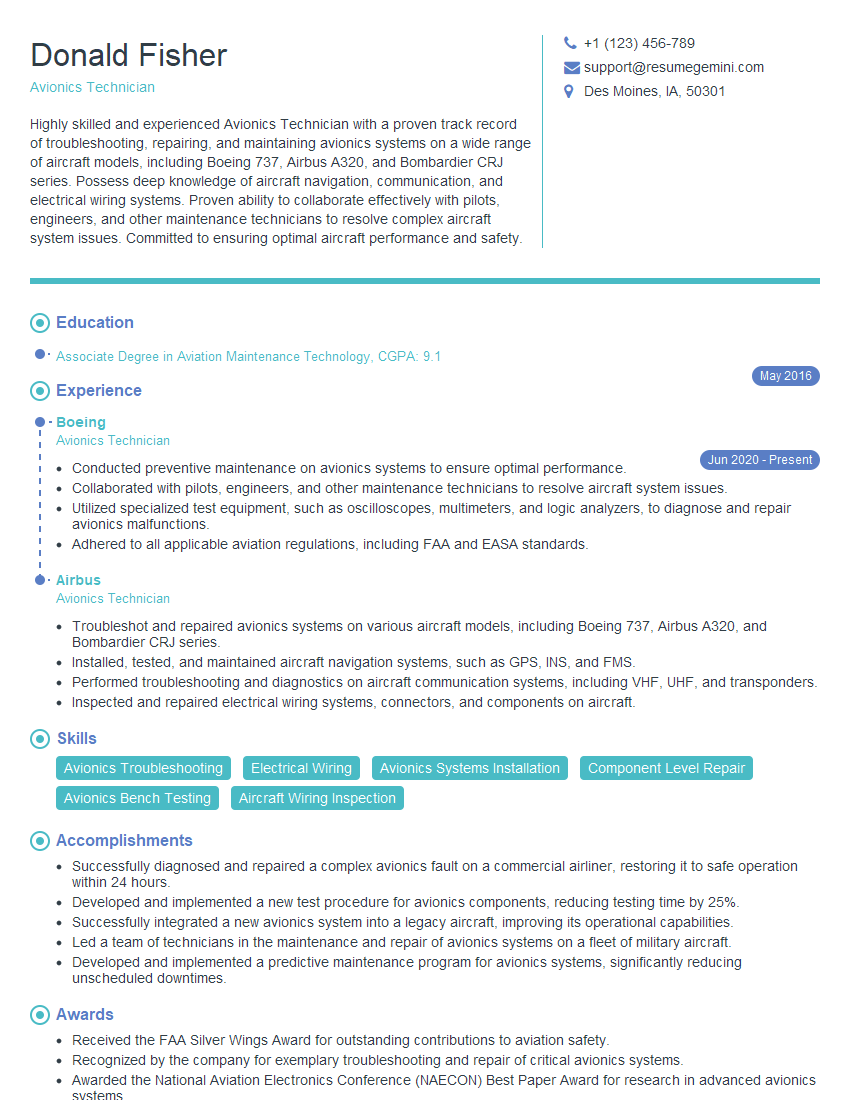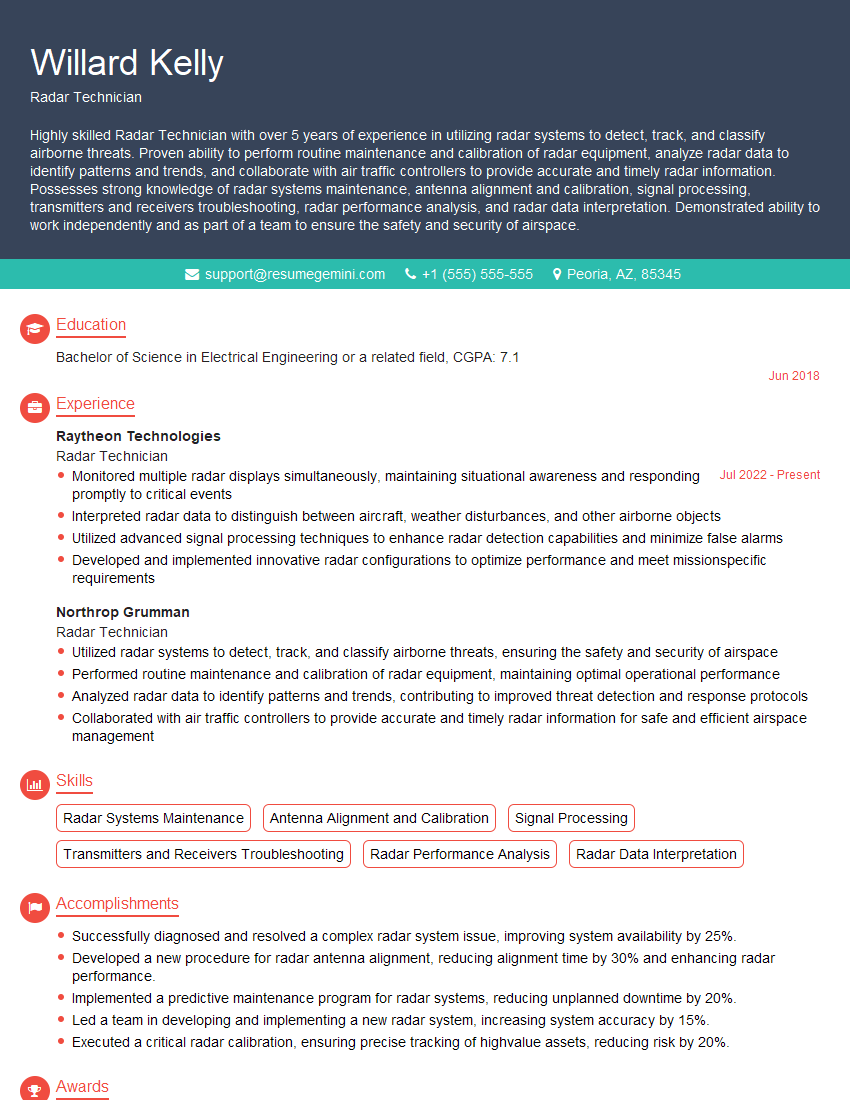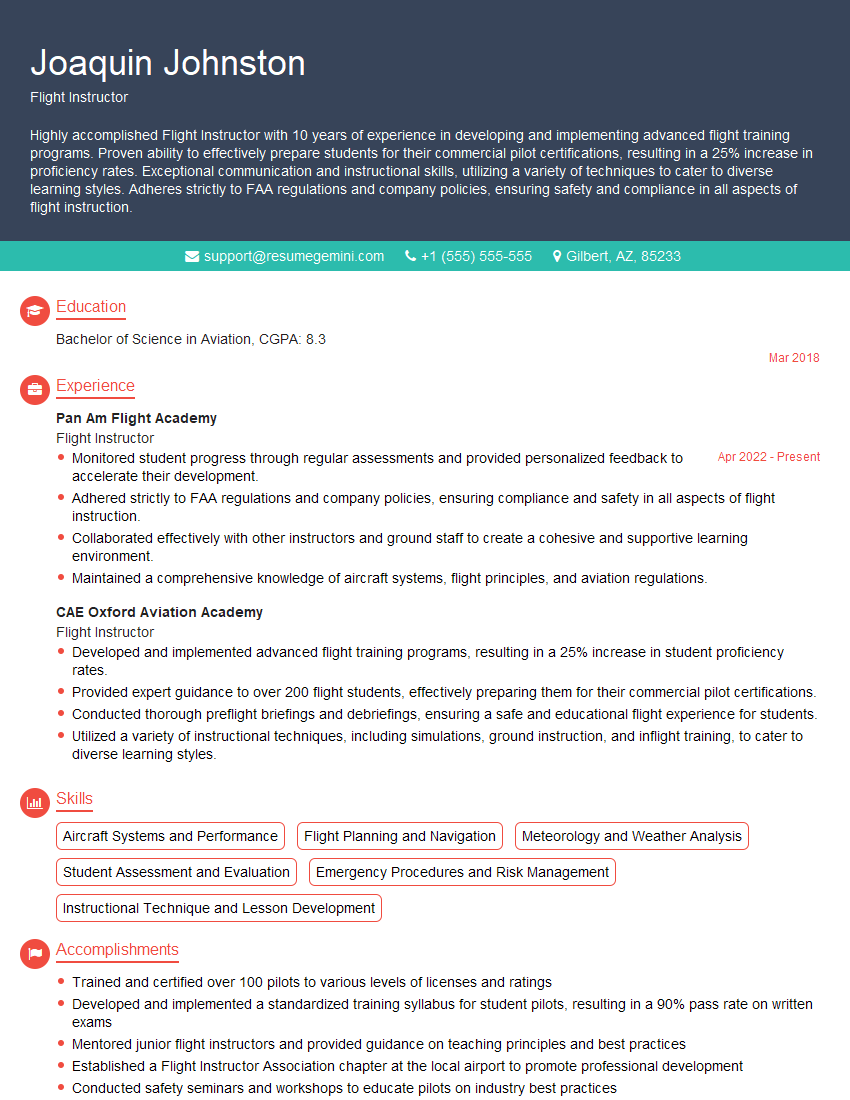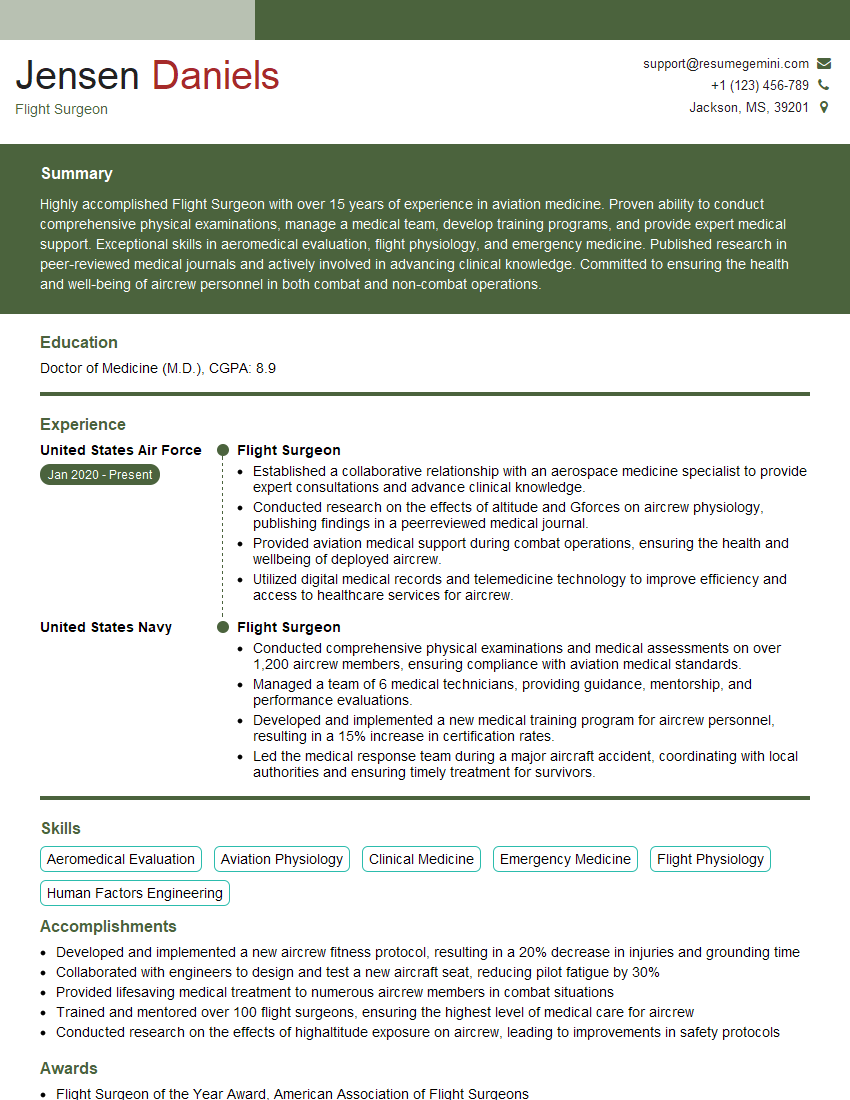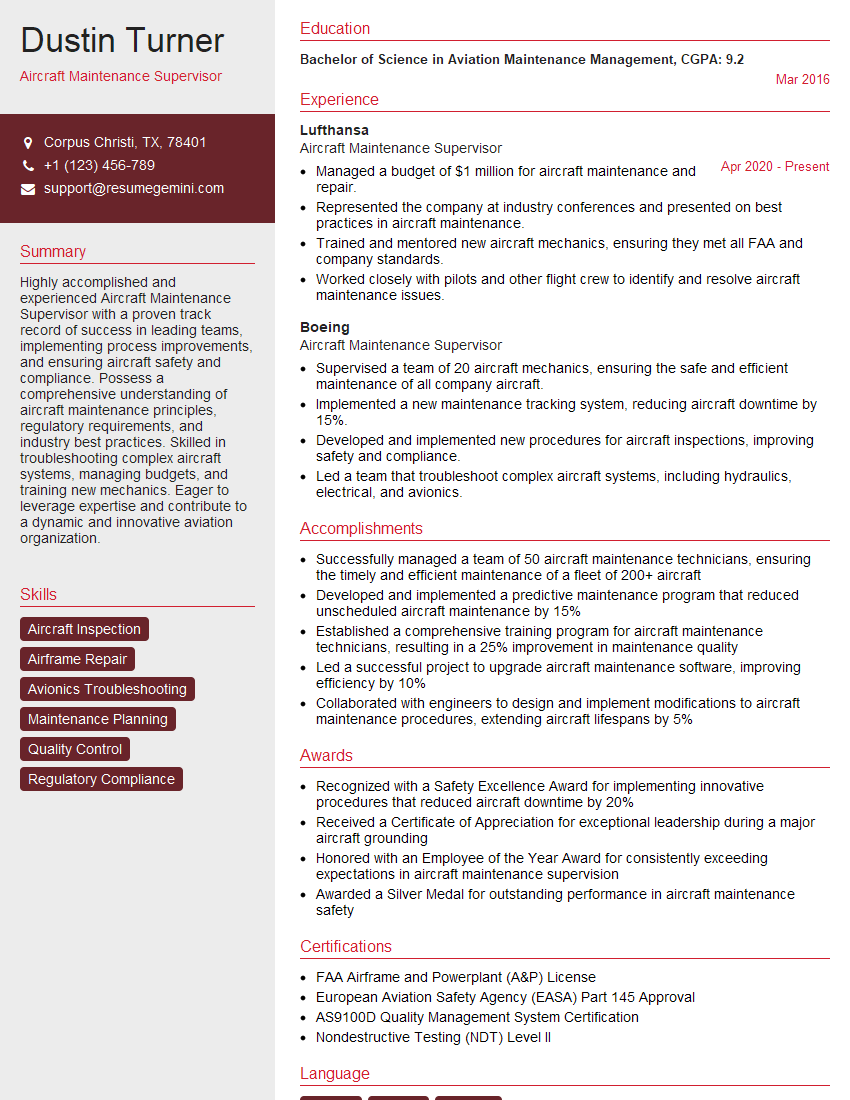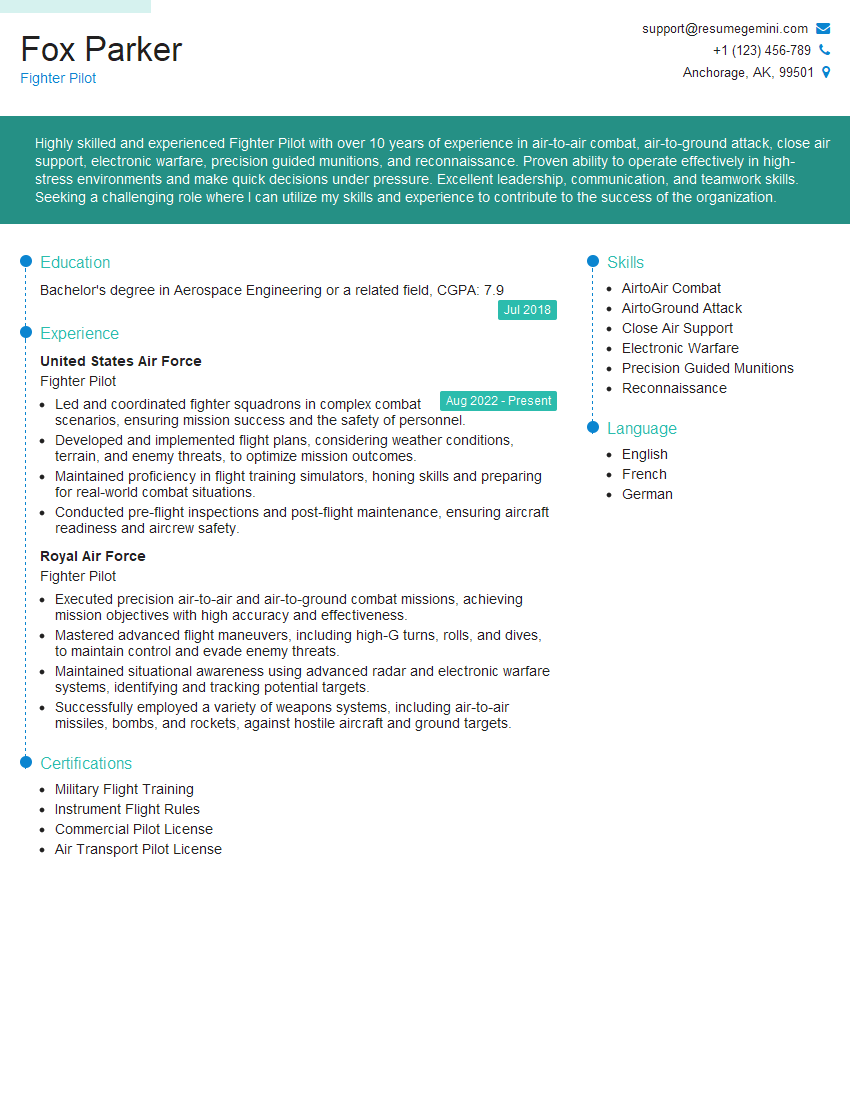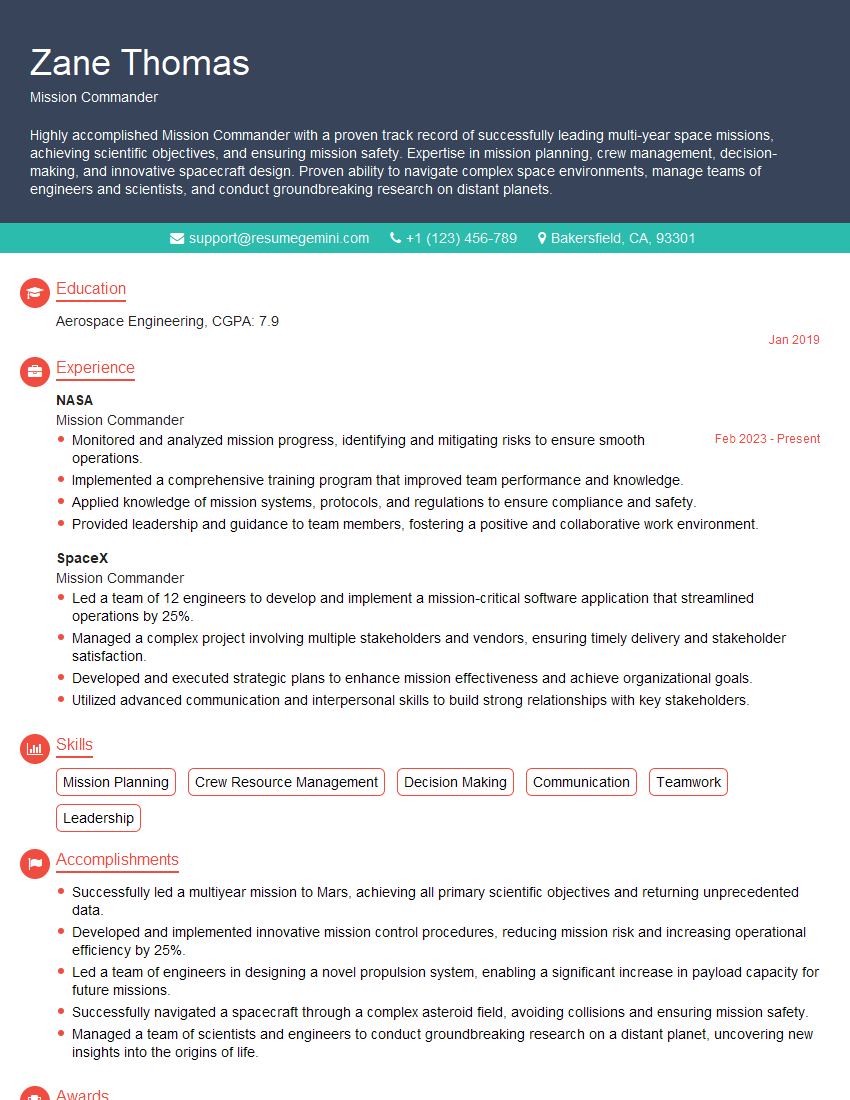Cracking a skill-specific interview, like one for Fighter Aircraft Operations, requires understanding the nuances of the role. In this blog, we present the questions you’re most likely to encounter, along with insights into how to answer them effectively. Let’s ensure you’re ready to make a strong impression.
Questions Asked in Fighter Aircraft Operations Interview
Q 1. Describe the flight envelope of a [Specific Fighter Aircraft Model].
The flight envelope of a specific fighter aircraft, let’s take the F-22 Raptor as an example, is a complex three-dimensional representation of all the airspeeds, altitudes, and angles of attack where it can safely and effectively operate. It’s not a simple range; it’s a defined space. The boundaries are determined by factors like structural stress limits, aerodynamic stability, engine performance, and controllability.
At lower altitudes, the F-22 can achieve extremely high speeds, approaching supersonic flight. As altitude increases, the thinner air impacts engine performance, reducing the maximum speed. Similarly, angles of attack – the angle between the aircraft’s longitudinal axis and the oncoming airflow – are limited to prevent stalls (loss of lift) or structural damage. These limits are often graphically represented in flight manuals, helping pilots understand the operational boundaries and avoid exceeding them, which could lead to catastrophic results.
Factors like maneuvering loads (the forces acting on the aircraft during turns) also define the flight envelope. High-G maneuvers, which are characterized by high acceleration forces, compress the flight envelope, limiting the aircraft’s capability at the extreme edges. The F-22’s advanced design allows a significantly broader flight envelope than many previous generations of fighters, enhancing its maneuverability and overall operational capabilities.
Q 2. Explain the principles of Basic Fighter Maneuvers (BFM).
Basic Fighter Maneuvers (BFM) are the fundamental air-to-air combat techniques used to gain and maintain an advantageous position over an opponent. Think of it as the foundation upon which more complex tactics are built. It’s all about energy management, positioning, and weapon delivery.
- Energy Management: This is crucial. A fighter’s energy state – a combination of altitude and speed – directly impacts its maneuverability. Conserving energy strategically is critical for surviving extended engagements. You don’t want to waste energy making unnecessary maneuvers.
- Positioning: The goal is to achieve a position of advantage relative to the opponent, which often involves controlling the aspect (the direction from which the opponent sees you). This can involve using terrain masking or positioning the sun behind you to limit your visibility.
- Weapon Delivery: This involves positioning for the most effective use of your aircraft’s weapons systems, considering factors such as missile launch envelopes and gunnery ranges. BFM aims to get you into a position where you can fire and the enemy cannot effectively respond.
A classic example is the ‘High-Yo-Yo’ maneuver, where a pilot uses altitude to gain speed and then aggressively maneuvers against an opponent, using their superior energy to gain a shooting position. BFM emphasizes defensive and offensive techniques; it’s not just about aggressive attack, but also how to effectively evade and reposition during engagement.
Q 3. What are the limitations of Beyond Visual Range (BVR) combat?
Beyond Visual Range (BVR) combat, where engagements occur beyond the visual range of pilots, offers significant advantages but also presents limitations. The primary advantage lies in the ability to engage targets at long distances, reducing the risk to the pilot.
- Reliance on Technology: BVR combat heavily relies on sophisticated sensors and data links. Any malfunction or jamming of these systems can significantly hinder combat effectiveness. This ‘technology dependence’ creates a vulnerability.
- Environmental Factors: Weather conditions such as heavy cloud cover or ground clutter can significantly degrade radar performance, limiting the effective range and accuracy of weapons.
- Probability of Kill: Even with advanced missiles, the probability of a successful kill is not guaranteed at extreme ranges. Factors such as target maneuvers and electronic countermeasures can greatly impact the outcome.
- Situational Awareness: The lack of visual confirmation of target damage can lead to difficulties in assessing engagement effectiveness. Did you hit your target? Without visual confirmation, it’s difficult to know for certain.
Essentially, while BVR combat provides a decisive advantage, it’s not a foolproof method. It necessitates exceptional situational awareness, careful target identification to avoid fratricide, and a reliance on complex technological systems whose failure can have serious consequences.
Q 4. How does radar work in a fighter aircraft context?
Fighter aircraft radar systems are sophisticated pulsed-Doppler radars that emit electromagnetic waves and then analyze the reflected signals (echoes) to detect, track, and identify targets. It works using the principle of radio waves bouncing off objects.
The radar transmits a pulse of radio waves. If the pulse hits an object, a portion of the energy is reflected back. The time it takes for the echo to return indicates the target’s distance. The Doppler effect – the change in frequency of a wave due to the relative motion between the source and receiver – is used to determine the target’s speed and direction. By analyzing these returns, the radar can paint a picture of the surrounding airspace, identifying potential threats, and providing targeting information.
Modern fighter radars are capable of tracking multiple targets simultaneously (multi-target tracking), even in cluttered environments. They employ advanced signal processing techniques to filter out noise and enhance the detection of small targets. Many include electronic counter-countermeasure (ECCM) capabilities to detect and counter enemy jamming attempts.
Imagine it like a bat using echolocation – only far more advanced. Instead of sound waves, radar uses radio waves to ‘see’ the environment. But unlike a bat, it also determines speed and identifies the nature of the detected object.
Q 5. Describe the process of target acquisition and engagement.
Target acquisition and engagement is a crucial sequence in air combat, involving several integrated steps:
- Detection: This often starts with the radar, detecting potential targets within its range. Other sensors, like infrared search and track (IRST) systems, can complement radar, particularly in environments where radar is less effective.
- Identification: Once a target is detected, the system needs to identify it – is it friendly, neutral, or hostile? This process often involves comparing the radar signature, transponder codes (if available), and visual identification (if within visual range).
- Tracking: The radar continuously tracks the target’s position and velocity, providing real-time updates to the weapon system.
- Weapon Selection: The pilot chooses the appropriate weapon based on the target’s type, range, and other factors. This might involve selecting air-to-air missiles or the aircraft’s internal cannon.
- Engagement: This involves aiming and launching the weapon. For missiles, this often requires precise maneuvering to ensure the missile intercepts its target successfully. For guns, this necessitates leading the target to compensate for its movement and the time it takes for the rounds to reach the target.
- Assessment: After the weapon is released, the pilot assesses the effectiveness of the engagement, often using sensors to confirm a hit or evaluating the target’s subsequent actions.
This process is highly dynamic and requires quick decision-making, based on real-time information presented to the pilot through sophisticated displays in the cockpit.
Q 6. Explain the role of Electronic Warfare (EW) in air combat.
Electronic Warfare (EW) plays a vital role in modern air combat, encompassing electronic attack (EA), electronic protection (EP), and electronic support (ES).
- Electronic Attack (EA): This involves using electronic means to degrade or deny the enemy’s ability to use their sensors and weapons. Examples include jamming enemy radar systems, disrupting communication links, or deploying decoys to confuse enemy targeting systems.
- Electronic Protection (EP): This focuses on protecting the aircraft from enemy EA. EP measures include using electronic countermeasures (ECM) to disrupt enemy jamming or using stealth technology to reduce the aircraft’s radar cross-section (RCS).
- Electronic Support (ES): This involves passively collecting and analyzing electromagnetic emissions from enemy systems to gain intelligence on enemy capabilities, locations, and intentions. ES can provide critical information for tactical decision-making.
EW is a critical aspect of achieving air superiority because the side that effectively controls the electromagnetic spectrum often gains a significant advantage in combat. A well-executed EW strategy can blind an enemy, protect your own assets, and ultimately influence the outcome of an engagement.
Q 7. What are the different types of air-to-air missiles and their capabilities?
Air-to-air missiles come in various types, each with unique capabilities:
- Short-Range Infrared (IR) Missiles: These missiles, like the AIM-9 Sidewinder, use infrared sensors to home in on the heat signature of an enemy aircraft’s engine. They are effective at close range but are susceptible to countermeasures like flares.
- Beyond Visual Range (BVR) Missiles: These missiles, such as the AIM-120 AMRAAM, use radar guidance to engage targets at long ranges. They are less dependent on visual acquisition and are less susceptible to IR countermeasures.
- Active Radar Homing (ARH) Missiles: These missiles have their own onboard radar to guide themselves to the target throughout the flight, providing better accuracy and resistance to countermeasures compared to semi-active radar homing (SARH) missiles that require continuous illumination from the launching aircraft’s radar.
- Passive Radar Homing (PRH) Missiles: These missiles home in on the radar emissions of the target, useful for engaging aircraft emitting radar signals, like those searching for other targets.
The choice of missile depends heavily on the range to the target, the threat environment, and the capabilities of the enemy aircraft. Modern fighter aircraft often carry a mix of different types to enhance versatility and effectiveness in various combat situations.
Q 8. Describe the procedures for emergency ejection.
Emergency ejection is a critical last resort in a fighter aircraft, and the procedures are rigorously trained and drilled. It’s a life-or-death scenario, so a calm, methodical approach is crucial even under extreme stress. The steps generally involve:
Assessment: Quickly assess the situation to confirm ejection is absolutely necessary. Is it a catastrophic failure, or is there a chance to recover? This split-second decision could save your life if a recovery is feasible.
Preparation: Ensure your harness is snug, your canopy is open (if required), and your ejection seat is armed. This includes checking for any obstructions in the cockpit that might hinder ejection.
Ejection: Once the decision is made, firmly pull the ejection handle. The specific procedure varies based on the aircraft model, but the general principle is a decisive action.
Post-Ejection: Follow post-ejection procedures, including releasing your harness, deploying your parachute, and securing your survival kit. You’ll likely need to assess your surroundings, identify a safe landing zone, and initiate rescue signals.
For example, during training simulations, we’ve practiced ejection scenarios with various malfunctions. One exercise involved a simulated engine fire, where we had to assess the severity and decide whether the flames could be extinguished or if ejection was the only option. Every pilot has their own specific ‘go/no-go’ criteria for emergency ejection, established through extensive training.
Q 9. How do you manage fuel consumption during a long-range mission?
Fuel management on long-range missions is crucial, as it directly impacts mission success and aircraft survivability. We utilize several techniques:
Pre-flight Planning: Mission planning meticulously calculates fuel requirements based on route, altitude, airspeed, and anticipated combat maneuvers. This often involves the use of specialized software that models fuel burn under various conditions.
Cruise Fuel Management: Maintaining optimal cruise altitude and airspeed minimizes fuel consumption. Slightly lower speeds mean better fuel efficiency, but it might compromise mission timing. This involves a constant trade-off between speed and fuel economy.
Combat Maneuvers: Aggressive maneuvers consume significantly more fuel. Pilots must judiciously select maneuvers, prioritizing efficiency while retaining the tactical advantage. We aim to limit high-G maneuvers unless absolutely critical.
Air Refueling (if applicable): Air-to-air refueling extends range significantly, enabling longer missions and greater operational flexibility. It requires precise coordination and specialized training for both the receiver and tanker aircraft.
Fuel Monitoring and Contingency Planning: Continuous monitoring of fuel levels is crucial. Contingency plans are developed to handle unforeseen situations, such as engine failure or unexpected delays. These might involve diverting to alternate airfields or adjusting mission parameters to conserve fuel.
For example, during a long-range reconnaissance mission, we meticulously planned our route to incorporate the wind and to minimize high-G turns to reduce fuel consumption while still successfully completing surveillance objectives.
Q 10. Explain the concept of air superiority.
Air superiority is the degree to which a nation or force can dominate its adversary in the air. It doesn’t necessarily mean total control, but it signifies the ability to engage enemy aircraft and prevent them from effectively impacting friendly forces. Achieving air superiority typically involves:
Suppression of Enemy Air Defenses (SEAD): Neutralizing or disabling enemy radar and missile systems to allow friendly aircraft to operate freely.
Air-to-Air Combat: Engaging and defeating enemy fighters, denying them the ability to interfere with friendly operations.
Intelligence, Surveillance, and Reconnaissance (ISR): Maintaining comprehensive awareness of enemy air assets, enabling timely response and effective targeting.
Technological Superiority: Possessing aircraft with advanced avionics, weapons, and sensors provides a crucial advantage in air combat.
Think of it like chess; air superiority means controlling key areas of the ‘board’ and preventing the opponent from effectively deploying their pieces. A nation with air superiority can significantly increase its chances of success in a conflict, as it allows for unimpeded movement of ground and naval forces.
Q 11. What are the key differences between visual and instrument flight rules (VFR/IFR) in combat scenarios?
Visual Flight Rules (VFR) and Instrument Flight Rules (IFR) represent fundamentally different ways of flying, with significant implications in combat scenarios.
VFR (Visual Flight Rules): Flying visually, relying on outside visual references to maintain orientation and navigation. It is typically used in good weather conditions with sufficient visibility. In combat, VFR might involve visually identifying and engaging targets. However, it makes the aircraft vulnerable to enemy fire and detection.
IFR (Instrument Flight Rules): Flying by instruments, relying on cockpit instrumentation and navigation systems for orientation and guidance. IFR is used in poor weather conditions or when visual references are unavailable. In combat, IFR allows for more clandestine operations, reducing vulnerability to detection but increasing reliance on technology and potentially limiting situational awareness.
The key difference in combat is risk versus stealth. VFR offers better situational awareness but makes you a more visible target. IFR reduces visibility but compromises awareness and maneuverability. The choice between VFR and IFR depends on mission objectives, weather conditions, and the threat environment. It’s not uncommon to transition between the two during a single mission.
Q 12. Describe your experience with pre-flight inspection procedures.
Pre-flight inspection is a non-negotiable procedure, a critical step to ensure the aircraft’s airworthiness and the safety of the pilot and mission. It’s a meticulous process, typically involving a checklist encompassing:
External Inspection: Visual examination of the aircraft’s exterior for any damage, leaks, or loose components.
Cockpit Checks: Verification of flight controls, instruments, communication systems, and ejection seat functionality.
Engine Checks: Starting the engines, checking oil pressure, fuel levels, and verifying their smooth operation.
Systems Check: Testing of various aircraft systems, including hydraulics, electrical systems, and navigation equipment.
I’ve performed countless pre-flight inspections across various aircraft types throughout my career. Every aircraft has its unique nuances. I remember once, during a pre-flight check, I noticed a minor crack in the canopy. This seemingly small issue could have posed significant risks during flight, highlighting the importance of thorough inspections. This incident led to the crack being promptly repaired, preventing what could have been a serious accident.
Q 13. How do you handle communication failures during a mission?
Communication failures are a serious threat during a mission, potentially jeopardizing situational awareness and coordination with other aircraft and ground control. Our training emphasizes several contingency plans:
Pre-planned Frequencies and Procedures: We establish backup communication frequencies and pre-arranged procedures to maintain contact in the event of primary communication failure. We may use different bands to stay connected if the primary link is lost.
Visual Signals: If radio communications fail, we rely on pre-agreed visual signals, such as wing rock, light flashes, or specific maneuvers, to convey critical information.
Emergency Procedures: We have designated emergency procedures for various scenarios, including communication failures. These procedures outline steps for maintaining situational awareness, returning to base, or receiving updated instructions via alternative methods.
Situational Awareness: Even without communication, maintaining maximum situational awareness is paramount. We use all available sensors and visual observation to understand the threat environment and navigate safely.
In one training exercise, we simulated a complete radio failure during a mock engagement. We successfully navigated the situation using pre-arranged visual signals and pre-planned maneuvers, highlighting the importance of redundant procedures. It’s a stark reminder that reliance on technology alone is insufficient; we always need a ‘plan B’.
Q 14. Explain the importance of situational awareness in fighter aircraft operations.
Situational awareness is the single most critical factor in fighter aircraft operations. It’s the ability to understand the current status and surrounding environment, enabling informed decision-making and effective action. It encompasses:
Self-Awareness: Understanding the aircraft’s status, fuel levels, weapons load, and limitations.
Environmental Awareness: Understanding the surrounding airspace, weather conditions, and the presence of friendly and enemy aircraft.
Threat Awareness: Identifying potential threats, assessing their capabilities, and predicting their intentions.
Without sufficient situational awareness, even the most skilled pilot can find themselves in a dangerous situation. It’s a complex interplay of visual observation, sensor data interpretation, and communication. I’ve seen experienced pilots make poor decisions due to a lapse in situational awareness, resulting in near misses or tactical errors. It requires constant vigilance, disciplined observation, and efficient processing of information.
Q 15. Describe your understanding of different types of aerial refueling.
Aerial refueling allows fighter aircraft to extend their range and endurance significantly, crucial for long-range missions. There are two primary methods:
- Probe-and-drogue: The receiving aircraft (fighter) uses a probe to connect with a drogue (a refueling receptacle on a hose) trailed from the tanker aircraft. This system is versatile and compatible with a wide range of aircraft types. Think of it like a gas station nozzle and hose, but in the sky.
- Boom system: The tanker aircraft extends a boom, a rigid refueling tube, which is manually guided by an operator on the tanker into a receptacle on the receiving aircraft. This method is generally faster and more efficient for large-scale transfers but requires more precise alignment and training. This is a more hands-on process, like carefully connecting a fuel pump to a car.
Both systems require specialized training and careful coordination between pilot and boom operator (in the boom system). The selection of which method to use depends on factors such as aircraft compatibility, weather conditions, and mission requirements. For example, a fast-paced interception mission might benefit from the speed of a boom system, while a long-range patrol might prioritize the versatility of the probe-and-drogue system.
Career Expert Tips:
- Ace those interviews! Prepare effectively by reviewing the Top 50 Most Common Interview Questions on ResumeGemini.
- Navigate your job search with confidence! Explore a wide range of Career Tips on ResumeGemini. Learn about common challenges and recommendations to overcome them.
- Craft the perfect resume! Master the Art of Resume Writing with ResumeGemini’s guide. Showcase your unique qualifications and achievements effectively.
- Don’t miss out on holiday savings! Build your dream resume with ResumeGemini’s ATS optimized templates.
Q 16. How do you assess the risks and threats in a given operational environment?
Assessing risks and threats in a fighter aircraft operation involves a systematic approach. We utilize a combination of intelligence reports, threat assessments (like potential enemy air defenses, ground-based weaponry, and adversary capabilities), and environmental factors (weather, terrain).
For instance, before a mission over a contested area, we’d analyze satellite imagery to pinpoint potential surface-to-air missile (SAM) sites and their estimated range. We’d cross-reference this with enemy activity reports to get a real-time picture. We would then plan our route and tactics to minimize risk, possibly employing low-altitude flight profiles to avoid radar detection or using electronic warfare assets to jam enemy radars.
This process isn’t just about identifying threats; it’s about assigning a risk level to each, prioritizing responses, and adjusting the mission plan accordingly. The goal is to mitigate risks to an acceptable level while still achieving mission objectives.
Q 17. What is your experience with mission planning and debriefing?
Mission planning is a detailed process that begins with understanding the mission objectives. This involves analyzing the target, assessing risks, determining the best routes and altitudes, coordinating with support assets (like tankers and AWACS), and meticulously planning all contingencies. I’ve been extensively involved in numerous missions, from close air support to deep penetration strikes.
Debriefings are equally crucial. They are a systematic review of the mission’s execution, comparing what was planned with what actually happened. This includes analyzing successes, failures, and identifying areas where procedures or training could be improved. A thorough debrief is vital for continuous improvement and learning. We use checklists and standardized reporting procedures to ensure no detail is missed. One example from a recent mission involved analyzing a delay in our refueling timeline. The debrief pinpointed a slight miscommunication with the tanker, which lead to a refinement of our communication protocols.
Q 18. Explain your understanding of air-to-ground weapons systems.
Air-to-ground weapons systems encompass a wide range of munitions, each with its own strengths and weaknesses. These include:
- Guided bombs: Like laser-guided bombs (LGBs) and GPS-guided bombs, offering precision strikes on specific targets, minimizing collateral damage.
- Unguided bombs: These require more precise delivery but are often simpler and cheaper.
- Rockets: Primarily used for area saturation attacks or suppressing enemy positions.
- Missiles: Precision-guided missiles like the AGM-65 Maverick are effective against various ground targets, while others are designed for anti-tank or anti-radiation roles.
Choosing the right weapon system depends on factors such as target type, weather conditions, and the level of precision required. For example, a high-value target like a bridge would likely call for an LGB, while attacking a group of vehicles might involve using rockets.
Q 19. Describe the procedures for engaging ground targets.
Engaging ground targets is a complex process involving several steps:
- Target acquisition: Identifying and verifying the target using sensors like radar, targeting pods, or visual observation.
- Weapon selection: Choosing the appropriate weapon system based on the target’s type, location, and environmental conditions.
- Weapons delivery: Accurately aiming and releasing the weapon, accounting for factors like wind, range, and target movement.
- Post-strike assessment: Confirming the weapon’s impact and evaluating the target’s destruction or neutralization. This often involves imagery analysis.
Strict rules of engagement (ROE) are followed to ensure civilian safety and to minimize collateral damage. Every engagement requires careful planning and execution to ensure mission success while adhering to those ROEs. A misstep can have severe consequences.
Q 20. How do you maintain situational awareness in a high-threat environment?
Maintaining situational awareness (SA) in a high-threat environment is paramount. It involves constantly monitoring multiple data streams to develop a complete and accurate picture of the operational environment. This includes:
- Radar and sensor data: Monitoring for enemy aircraft, ground threats, and weather conditions.
- Communication with AWACS and ground control: Receiving crucial real-time information about threats and friendly forces.
- Visual scanning: Continuously looking around for threats both inside and outside the cockpit, which are often overlooked.
- Using electronic warfare systems: Detecting and identifying enemy emitters, gaining a better understanding of their capabilities and intentions.
Situational awareness isn’t static; it’s a dynamic process that demands constant vigilance and adaptation. A breakdown in SA can have dire consequences. For example, a pilot failing to notice an approaching enemy fighter jet could result in a fatal encounter. Therefore, efficient team communication is crucial in preserving SA.
Q 21. Explain your understanding of different types of countermeasures.
Countermeasures are defensive systems designed to protect aircraft from enemy threats. They can be broadly categorized into:
- Electronic countermeasures (ECM): These systems jam enemy radar signals, making it difficult to track and target the aircraft. This can involve deploying chaff (aluminum strips) and flares (infrared countermeasures) to distract heat-seeking missiles.
- Defensive maneuvers: Evasive maneuvers, like high-G turns or abrupt changes in altitude and direction, can help evade enemy weapons.
- Physical countermeasures: These might include armor plating for protection against some types of weapons or structural designs to mitigate the impact of damage.
The specific countermeasures used depend on the nature of the threat. For example, against a heat-seeking missile, flares are crucial; against radar-guided missiles, chaff and ECM jamming are critical. A well-trained pilot understands how to utilize these countermeasures effectively in combination to minimize the risk of being hit.
Q 22. How do you handle in-flight emergencies?
Handling in-flight emergencies requires a calm, systematic approach based on established procedures. The first step is always to assess the situation – what’s the nature of the emergency? Is it a systems malfunction, a fire, an enemy engagement, or something else? Once assessed, the next step is to prioritize actions based on the severity and urgency. This usually involves following a checklist, which is specific to the type of aircraft and emergency. For example, if it’s an engine fire, the checklist will guide the pilot through the steps to shut down the engine, deploy fire suppression systems, and initiate an emergency landing procedure. If it’s a loss of critical systems, the pilot must make quick decisions about what systems to attempt to regain control of and whether to eject or attempt a controlled landing. Communication with air traffic control is crucial throughout the entire process, keeping them informed of the situation and the pilot’s intentions. Practice and experience are key, as simulations and training exercises help pilots develop the quick thinking and decision-making needed during these high-pressure situations.
A classic example would be a loss of hydraulic pressure. This requires prioritizing flight controls, assessing damage, and smoothly executing an emergency landing using backup systems. Effective communication with air traffic control would be key in finding the safest landing zone and coordinating with emergency services.
Q 23. What are your strengths and weaknesses as a pilot/WSO?
My strengths as a pilot/WSO lie in my strong analytical skills, decisive decision-making under pressure, and exceptional situational awareness. I thrive in complex environments and excel at coordinating with other members of the flight crew. I am a quick learner and highly adaptable to new technologies and challenging circumstances. I am also meticulous in my attention to detail, which ensures the safety and efficiency of our operations. For example, my analytical skills were critical during a recent exercise where we had to adapt our flight plan to changing weather conditions, which required me to quickly assess the risk and recalculate optimal flight paths.
My weakness is occasionally being overly focused on completing a task perfectly, which may require consciously making sure I am delegating accordingly and balancing perfectionism with practical time management. This is something I actively work on through self-reflection and feedback from my colleagues and supervisors. I am confident in my ability to consistently improve upon this area through active participation in debriefs and continuing education.
Q 24. Describe a challenging mission and how you overcame obstacles.
During a low-level night flight mission, we encountered unexpected severe weather – a sudden, violent thunderstorm. Our original flight path became impassable. The immediate challenge was maintaining situational awareness in the near-zero visibility and high turbulence. We also faced the risk of colliding with terrain in the mountainous region. Overcoming this required quick, collaborative decision-making. The WSO used advanced weather radar and terrain-following systems to identify a safer, albeit more challenging, route through the storm. The pilot expertly navigated the severe turbulence, maintaining aircraft control and structural integrity. We successfully adapted our mission parameters to complete our objectives while prioritizing safety, adapting our approach and using available technology to achieve our primary goals of navigating the unexpected weather.
This mission highlighted the crucial importance of teamwork, adaptability, and trust within the cockpit. The successful completion emphasized the value of extensive training in handling challenging situations and the importance of relying on each other’s expertise and experience.
Q 25. How do you stay updated on the latest advancements in fighter aircraft technology?
Staying updated on advancements in fighter aircraft technology is critical to maintaining operational effectiveness and proficiency. I utilize several methods to achieve this. Firstly, I actively participate in professional development courses and seminars offered by the air force and industry leaders. These courses cover the latest upgrades to existing systems and introduce entirely new technologies. Secondly, I regularly review industry publications, journals, and technical reports which often contain valuable insights into current and emerging technologies. Thirdly, I participate in simulations using the latest flight software and engage in discussions with engineers and other pilots to learn about new developments and share experiences. Finally, I make an effort to familiarize myself with the latest technological advancements and upgrades implemented in our fleet of aircraft.
An example of this would be staying abreast of the development and deployment of advanced sensors and targeting systems – crucial for maintaining a competitive edge in modern warfare.
Q 26. Describe your experience with different flight control systems.
My experience encompasses a range of flight control systems, from traditional hydraulic systems to more advanced fly-by-wire (FBW) systems. Understanding these systems is crucial for safe and effective flight operations. With traditional hydraulic systems, the pilot’s inputs are directly translated to control surface movements through hydraulic pressure. FBW systems, however, introduce a computer interface between the pilot’s inputs and control surface movements, allowing for increased maneuverability and flight envelope protection. This added layer of computer control provides increased stability and safety while also offering more challenging and demanding aspects to master. I’ve flown aircraft with both systems, gaining a comprehensive understanding of their strengths, limitations, and operational nuances. This allows me to seamlessly adapt to various aircraft and situations.
Understanding the limitations of both systems is equally crucial. For instance, in FBW systems, a computer malfunction could potentially disable or compromise flight control, so it’s essential to understand backup procedures and flight envelope limits.
Q 27. Explain the role of teamwork in a fighter aircraft squadron.
Teamwork is absolutely paramount in a fighter aircraft squadron. It’s not just about the pilot and WSO in the cockpit; it’s about the entire team, including maintenance crews, intelligence analysts, support staff, and fellow pilots. Effective communication, mutual trust, and shared understanding are the cornerstones of a successful squadron. The pilot and WSO need to rely on each other implicitly; each role possesses specialized knowledge vital to the mission. The ground crew’s meticulous work ensures the aircraft is ready for flight, while intelligence analysts provide the situational awareness necessary for mission planning and execution. Effective teamwork ensures that everyone’s expertise is efficiently used in service of the larger mission, leading to improved performance and safety.
For example, during a complex air-to-air refueling operation, the coordinated efforts of multiple aircraft and ground control are essential to achieve a safe and successful transfer. Clear communication among all parties is critical to guarantee the operation proceeds without incident.
Q 28. How do you ensure mission success while adhering to safety regulations?
Ensuring mission success while adhering to safety regulations is a delicate balance. It’s not a question of choosing one over the other; it’s about integrating them seamlessly. Safety regulations are not obstacles; they are integral parts of the mission, guiding our actions and minimizing risks. Before any mission, we conduct thorough risk assessments that consider all potential hazards and challenges. These assessments include the aircraft’s mechanical status, weather conditions, and potential enemy threats. We create contingency plans to address potential problems, ensuring that backup options are in place. During the mission, we maintain constant vigilance and adherence to safety protocols, including maintaining proper spacing and avoiding unnecessary risks. This approach ensures that the mission’s goals are achieved without compromising the safety of the aircrew or the aircraft. It’s about strategic risk management – accepting calculated risks within safety parameters while prioritizing the well-being of the team and the successful completion of the mission.
For instance, during a close-air-support mission, we must balance the need for precision strikes with the avoidance of civilian casualties. Following established rules of engagement and adhering to strict safety protocols are paramount in this kind of scenario.
Key Topics to Learn for Fighter Aircraft Operations Interview
- Aircraft Systems and Capabilities: Understanding the intricacies of fighter jet systems (avionics, flight controls, weapons systems) and their practical limitations.
- Mission Planning and Execution: Developing and executing mission plans, including route planning, target acquisition, and engagement strategies. Consider the impact of weather, terrain, and enemy capabilities.
- Air Combat Maneuvering (ACM): Mastering the theoretical principles and practical applications of ACM techniques, including energy management, positioning, and weapons delivery.
- Tactical Data Links (TDLs) and Communication: Understanding the role of TDLs in coordinating with other aircraft and ground units, emphasizing effective communication protocols under pressure.
- Weapons Employment and Delivery: Knowledge of various weapon systems, their capabilities, and effective deployment strategies in diverse scenarios.
- Threat Assessment and Risk Management: Analyzing potential threats, assessing risks, and developing mitigation strategies to ensure mission success and crew safety.
- Emergency Procedures and Flight Safety: Understanding emergency procedures, aircraft limitations, and safety protocols to handle unexpected situations effectively.
- Rules of Engagement (ROE) and Laws of Armed Conflict (LOAC): Comprehensive knowledge of ROE and LOAC to ensure legal and ethical conduct during operations.
- Mission Debriefing and Analysis: Critically analyzing mission performance, identifying areas for improvement, and contributing to continuous learning within the team.
Next Steps
Mastering Fighter Aircraft Operations opens doors to a challenging and rewarding career, offering opportunities for advancement and specialization within the aviation field. A strong resume is crucial for showcasing your expertise and securing your desired role. An ATS-friendly resume, optimized for Applicant Tracking Systems, significantly increases your chances of getting your application noticed. ResumeGemini is a trusted resource to help you craft a compelling and effective resume that highlights your unique skills and experience in Fighter Aircraft Operations. Examples of resumes tailored to this specific field are available to guide you through the process.
Explore more articles
Users Rating of Our Blogs
Share Your Experience
We value your feedback! Please rate our content and share your thoughts (optional).
What Readers Say About Our Blog
Hello,
We found issues with your domain’s email setup that may be sending your messages to spam or blocking them completely. InboxShield Mini shows you how to fix it in minutes — no tech skills required.
Scan your domain now for details: https://inboxshield-mini.com/
— Adam @ InboxShield Mini
Reply STOP to unsubscribe
Hi, are you owner of interviewgemini.com? What if I told you I could help you find extra time in your schedule, reconnect with leads you didn’t even realize you missed, and bring in more “I want to work with you” conversations, without increasing your ad spend or hiring a full-time employee?
All with a flexible, budget-friendly service that could easily pay for itself. Sounds good?
Would it be nice to jump on a quick 10-minute call so I can show you exactly how we make this work?
Best,
Hapei
Marketing Director
Hey, I know you’re the owner of interviewgemini.com. I’ll be quick.
Fundraising for your business is tough and time-consuming. We make it easier by guaranteeing two private investor meetings each month, for six months. No demos, no pitch events – just direct introductions to active investors matched to your startup.
If youR17;re raising, this could help you build real momentum. Want me to send more info?
Hi, I represent an SEO company that specialises in getting you AI citations and higher rankings on Google. I’d like to offer you a 100% free SEO audit for your website. Would you be interested?
Hi, I represent an SEO company that specialises in getting you AI citations and higher rankings on Google. I’d like to offer you a 100% free SEO audit for your website. Would you be interested?
good
